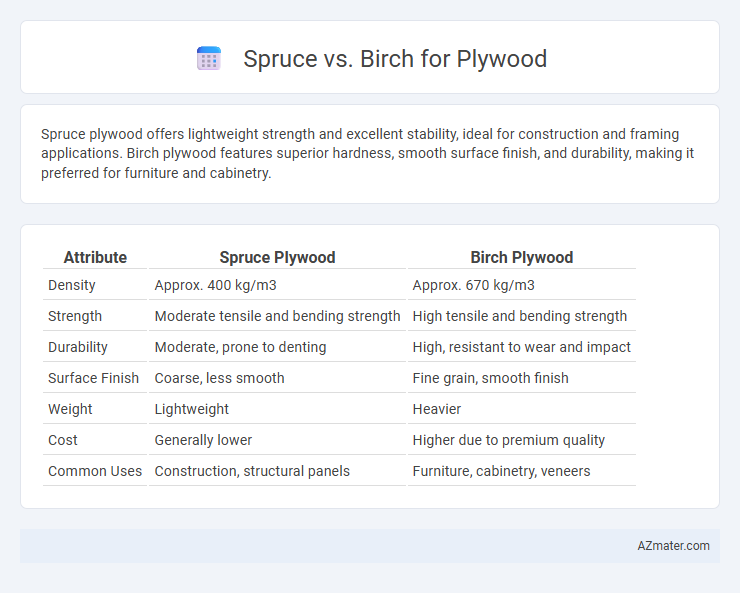Spruce plywood offers lightweight strength and excellent stability, ideal for construction and framing applications. Birch plywood features superior hardness, smooth surface finish, and durability, making it preferred for furniture and cabinetry.
Table of Comparison
| Attribute | Spruce Plywood | Birch Plywood |
|---|---|---|
| Density | Approx. 400 kg/m3 | Approx. 670 kg/m3 |
| Strength | Moderate tensile and bending strength | High tensile and bending strength |
| Durability | Moderate, prone to denting | High, resistant to wear and impact |
| Surface Finish | Coarse, less smooth | Fine grain, smooth finish |
| Weight | Lightweight | Heavier |
| Cost | Generally lower | Higher due to premium quality |
| Common Uses | Construction, structural panels | Furniture, cabinetry, veneers |
Introduction to Spruce and Birch Plywood
Spruce plywood is valued for its lightweight nature and high strength-to-weight ratio, making it a preferred choice in construction and furniture manufacturing. Birch plywood offers exceptional durability and a smooth finish, ideal for applications requiring high aesthetic appeal and structural integrity. Both spruce and birch plywood types are widely used due to their unique combination of strength, stability, and versatility in various building projects.
Botanical Differences: Spruce vs Birch
Spruce plywood is derived from trees in the Picea genus, characterized by softwood fibers with a straight grain and lighter color, contributing to lightweight and good strength-to-weight ratio panels. Birch plywood originates from trees in the Betula genus, featuring hardwood fibers with a fine, uniform grain and creamy color, resulting in durable, denser, and more rigid sheets. These botanical differences influence the plywood's application, with spruce favored for structural use due to flexibility and birch preferred for aesthetic and load-bearing purposes due to its hardness.
Physical and Mechanical Properties
Spruce plywood exhibits a higher strength-to-weight ratio and better stiffness compared to birch, making it ideal for structural applications requiring lightweight materials. Birch plywood offers superior hardness and durability due to its dense grain structure, resulting in enhanced resistance to impact and wear. Both woods have comparable moisture resistance, but birch plywood generally achieves higher mechanical stability under varying environmental conditions.
Plywood Manufacturing Processes
Spruce plywood offers a lighter weight option due to its lower density, enabling easier handling and transportation during manufacturing, while birch plywood provides superior strength and durability, making it ideal for structural applications. The manufacturing process of spruce plywood often involves thinner veneers that bond well with adhesives, enhancing flexibility and reducing production costs. Birch plywood requires precise drying and pressing techniques to manage its higher moisture content and hardness, ensuring uniform layering and a smooth finish critical for premium-grade products.
Strength and Durability Comparison
Spruce plywood offers excellent strength-to-weight ratio, making it ideal for structural applications where lightweight yet sturdy materials are required. Birch plywood is renowned for its superior durability and resistance to wear, providing a harder surface that withstands heavy use and impact. When comparing strength and durability, birch plywood generally outperforms spruce due to its tighter grain and higher density, ensuring longer-lasting performance in demanding environments.
Aesthetic Appeal and Grain Patterns
Spruce plywood features a light, creamy color with subtle, uniform grain patterns that provide a clean and minimalist aesthetic, often preferred for modern design applications. Birch plywood offers a warmer, more varied grain with a fine texture and pale yellow to reddish-brown hues, making it ideal for furniture and decorative panels where rich visual interest is desired. The choice between spruce and birch plywood for aesthetic appeal largely depends on whether a sleek, understated look or a warm, intricate grain pattern is prioritized in the final project.
Workability and Machining Characteristics
Spruce plywood offers superior workability with its lightweight structure and consistent grain, making it easy to cut and shape while minimizing tool wear. Birch plywood features a denser, harder surface that provides excellent machinability for precision tasks but can cause increased tool dulling and requires sharper blades. Choosing between Spruce and Birch depends on the balance between ease of handling and the need for a durable, fine finish in plywood applications.
Common Applications and Uses
Spruce plywood is commonly used in construction for subflooring, wall sheathing, and roof decking due to its lightweight and good strength-to-weight ratio. Birch plywood is preferred for cabinetry, furniture, and high-end interior applications because of its durability, smooth finish, and attractive grain. Both types serve well in structural and decorative roles, but birch plywood is often chosen when surface appearance and sanding quality are critical.
Cost and Availability
Spruce plywood typically offers a more cost-effective solution due to its widespread availability and faster growth rates, making it a popular choice in construction and carpentry. Birch plywood, while generally more expensive, provides superior strength and durability, often preferred for furniture and high-end applications. Availability of birch can be limited in certain regions, driving up its price compared to the more abundant spruce options.
Environmental Impact and Sustainability
Spruce plywood is generally favored for its fast growth rate and higher carbon sequestration, making it a more sustainable choice in forestry management compared to birch. Birch plywood, while durable and dense, typically requires slower-growing hardwood resources, which can lead to greater environmental strain when harvested unsustainably. Sustainable forestry certifications, such as FSC or PEFC, play a crucial role in ensuring the environmental impact of both spruce and birch plywood is minimized.

Infographic: Spruce vs Birch for Plywood
 azmater.com
azmater.com